Introduction: What is a Myocardial Infarction or heart attack?
Heart disease is on the rise due to an increase in our population’s risk factors such as diabetes, obesity, hypertension (high blood pressure), high cholesterol, lack of physical activity, smoking, etc.
A myocardial infarction (MI) is caused by a complete blockage of an artery to the heart muscle because of a blood clot (thrombus). It usually affects one of the coronary arteries that supply your heart. The portion of the heart affected becomes damaged. It dies if blood flow is not established promptly. Delay in the treatment leads to greater heart damage and more complication. Hence, early identification of a heart attack is paramount in saving lives.

What Causes a Myocardial Infarction (MI) or heart attack?
There are several causes of a heart attack. The most common causes of myocardial infarction or heart attack are:
- Smoking
- Diabetes
- Hypertension or high blood pressure
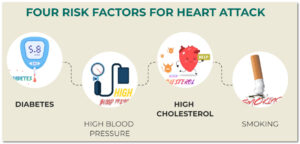 High cholesterol or dyslipidemia or hypercholesterolemia
High cholesterol or dyslipidemia or hypercholesterolemia- Genetic
- Stress
- Lack of physical activity
- Obesity
- Unhealthy food
- Cocaine abuse
- Birth control pills or oc pills
- Kawasaki disease
How to Know If You’re Having a Heart Attack
A heart attack usually causes severe chest pain, but there are other signs and symptoms you should look out for if you believe you or someone you know might be having one.
But the signs can be subtle, so many people don’t even realize they’re having a heart attack until it’s too late.
Symptoms of a heart attack vary from a person to person. Chest pain which starts all of a sudden is the most classical complaint of a heart attack, Various complaints reported by our patients with heart attacks are:
- Chest pain
- Left-arm pain
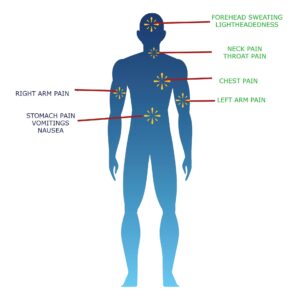 Right arm pain
Right arm pain- Neck pain, Throat pain
- Sweating
- Lightheadedness, dizziness (giddiness)
- Nausea, vomiting
- Stomach ache
- Fainting
Complications of a heart attack:
A. Heart failure
A heart attack weakens the heart abruptly which can lead to congestive heart failure. In heart failure, the heart is incapable of pumping adequate blood to the body. It leads to the build-up of the fluid in the body and lungs.
B. Lung congestion or pulmonary edema
Heart attack makes the heart weak. A weak heart can not pump blood effectively. This leads to a build-up of fluid in the lungs. Fluid in the lung causes difficulty in breathing (dyspnoea), cough, inability to lie down, and frothy sputum.
C. Sudden death or SCD
The majority of sudden deaths with a heart attack occur during the first one hour, Abnormal heart rhythms, heart failure, and rupture of the heart are a few causes of a sudden death
D. Abnormal heart rhythm or arrhythmias
Heart attack can predispose you to various rhythm abnormalities like rapid heart rate (Sinus tachycardia or ventricular tachycardia), slow heart rate )sinus bradycardia or complete heart block, and irregular heart rate (ventricular fibrillation or atrial fibrillation) and so on. Some of these arrhythmias are life-threatening and can lead to sudden death if not treated promptly
E. Rupture of the heart
A heart attack makes a portion of the heart can give away to the pressure inside the heart. This is a deadly complication and needs immediate open-heart surgery
F. Rupture of the wall of the heart
The Wall of the heart between the right side and the left side is known as the septum or interventricular septum. This septum when involved in a heart attack may rupture. It creates a hole between the right and left sides of the heart. it is a serious complication of a heart attack.
G. Damaged valves or Faulty valves
Mitral regurgitation or leaking mitral valve can occur due to damage to the mitral valve during a heart attack, If the blood vessel that supplies the mitral valve is involved in the heart attack, severe mitral regurgitation can occur. This needs repair or replacement through open-heart surgery
H. Fluid around the heart or pericardial effusion
Fluid can build up around the heart after a heart attack. If accumulated fluid prevents the heart from expanding, you will need immediate removal of the fluid through a minor procedure.
I. Kidney damage
The heart and kidneys are related to each other. With a major heart attack, the kidney may fail due to low blood pressure and or heart failure. Dye given during angioplasty can damage the kidney
J. Liver damage
Heart failure can lead to congestion of the liver and liver damage
K. Brain stroke
A clot can form inside the heart after myocardial infarction, the clot can migrate to the brain and cause a brain stroke. Blood thinners and drugs used for thrombolysis during the treatment of a myocardial infarction can cause bleeding in the brain.
L. A clot in the heart
A portion of the heart that becomes dead with a heart attack is predisposed to the formation of the clot on top of it
Tests for a heart attack
A heart attack is a medical emergency and diagnosis should be done promptly. Every chest pain in a susceptible person should be considered a myocardial Infarction or heart attack. You should have an initial assessment by your doctor to rapidly confirm or exclude the diagnosis of a heart attack. Rapid diagnosis of a heart attack should be the goal of the hospital.
1. ECG or electrogram
ECG or electrogram is the first test to be performed for the diagnosis of a heart attack. ECG has to be done within ten minutes of hospital arrival to identify the key findings of a heart attack. Certain ECG findings are the hallmark of myocardial infarction and many patients can have a diagnosis of a heart attack just by history and ECG.
Diagnoses heart attack with just history and an EKG test in above 95 percent of cases. In very few cases, ECG can be normal or near-normal. This is possible especially when ECG is done too early, or heart attack is mild or heart attack affected the posterior portion of the heart. In that case, your doctor may repeat the ECG test after 1 hour (serial ECG). Sometimes ECG changes may appear in the repeat ECG. If myocardial infarction or heart attack is confirmed on ECG, you will be given treatment immediately. If there are no confirmatory changes in the ECG, your doctor will advise a blood test called troponin. If troponin is positive, you are more likely to have a heart attack.
2. 2d echo test
2d echo test is an imaging tool to scan the heart. 2d echo test is not needed to establish the diagnosis of a heart attack but it can conform heart attack diagnosed by ECG. Regional wall motion abnormalities (RWMA) are the hallmark of myocardial infarction or heart attack. A portion of the heart does not move or move slowly in a 2d echo scan after a heart attack. this is called RWMA. It is helpful in various ways in a heart attack like
- To know the extent of a heart attack
- To identify the Area of the heart affected by a heart attack
- To calculate the prognosis of a heart attack
- To find Complications after a heart attack
- To monitor response to treatment
- To assess Heart function
3. Troponin test
The troponin blood test checks your blood sample for the presence of troponin, which can indicate if you have had a heart attack. Results are typically available within minutes with a card test. The degree of elevation in troponin is proportional to the severity of a heart attack. Severe myocardial infarction produces several times elevation of troponins. A mild heart attack may rise troponins slightly. It is possible to have elevated troponins without a heart attack. For example, troponin is elevated in other skeletal muscles that are damaged (Crush injury to leg, etc)
4. Chest x-ray
Chest X-rays are a type of medical imaging that can show the structures in the chest, such as the lungs and heart. It is used to know lung congestion (pulmonary edema) which can happen with a heart attack.
5. Coronary Angiogram test
Coronary angiography is a diagnostic procedure that uses X-rays to look at the blood vessels in the heart. It can show the flow of blood in the arteries of the heart (coronaries) and look for blockages in them. In a heart attack, coronary arteries that supply your heart get blocked severely with cholesterol and a blood clot. coronary angiography (CAG) is the only test that can reveal the location of the blockages, number of blockages, and severity of the blockages. An angiogram procedure helps your heart specialist to make a decision regarding the treatment plan. Your cardiologist decides if medicines or stent surgery or both are right for your heart attack after a heart angiogram. Rarely, you may need CABG (bypass surgery) for your heart attack.
6. Other tests
Serum electrolytes, renal function tests, complete blood picture, and coagulopathy, liver function test, and viral markers like HIV, HCV, and HbsAg are routinely sent to every hospital patient who gets admitted
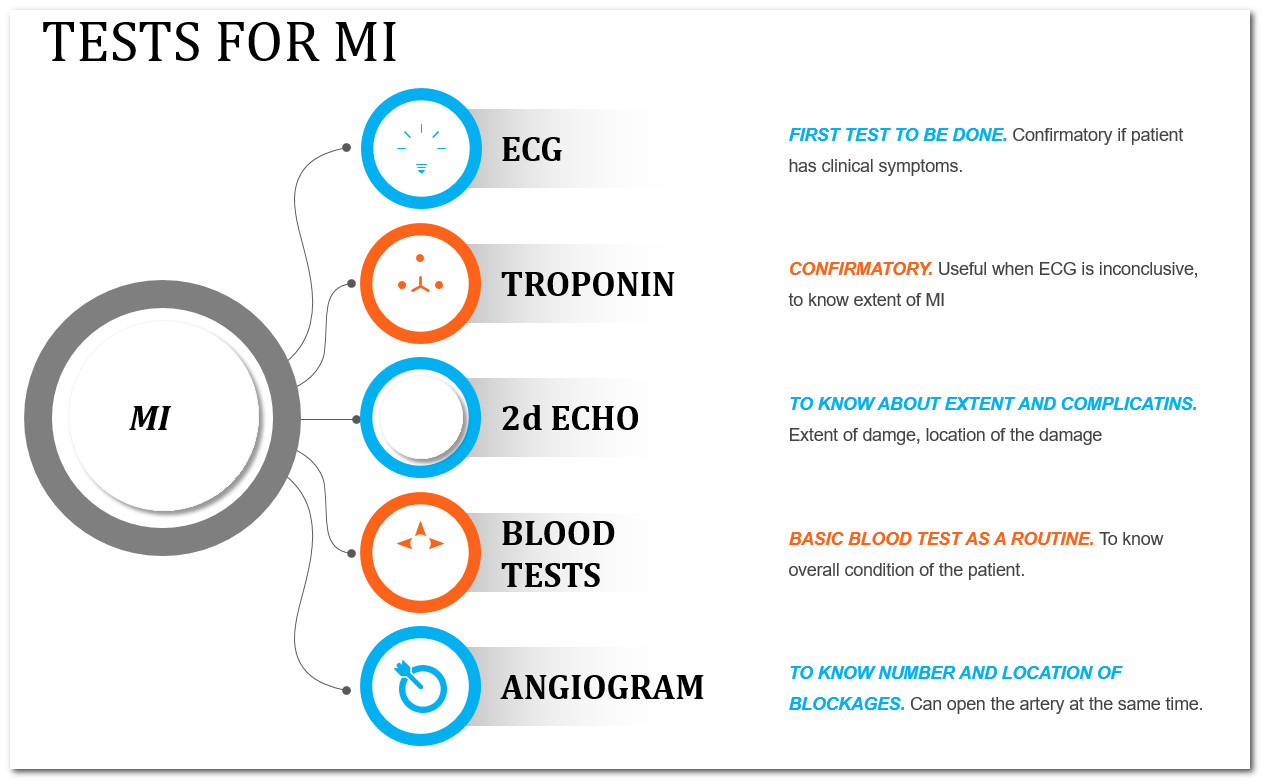
Remember that, treatment should not be delayed for the sake of investigations.
How to Treat Myocardial Infarctions
If you suspect you have a heart attack, follow these steps:
1) Call an ambulance or rush to the hospital
2) If you can, take an aspirin
3) If you’re experiencing chest pain or discomfort, take nitroglycerin
4) Stay calm
The bottom line is this- if you’ve had a heart attack, rush to the nearest hospital immediately
In the hospital, You will connect to a machine that continuously monitors your blood pressure, heart rate, and oxygen saturation. Once the diagnosis of myocardial infarction is made, you will be given blood thinners and other medicines to consume. The health care team will address your individual needs based on your medical history, other medical conditions, risks, age, and other factors.

The goal of management is to rapidly establish blood flow to the occluded coronary artery (which always happens with a heart attack). For that, there are two kinds of treatments available.
They are:
- Thrombolysis therapy
- Primary PTCA or heart stent surgery or angioplasty
You should decide within 5 to 10 minutes of arrival at the hospital as delay leads to more complications.
I. Thrombolysis therapy for heart attack or MI
Thrombolysis is the use of drugs, usually given intravenously, to dissolve blood clots that are blocking blood flow in arteries to the heart muscle. A myocardial infarction (MI) is caused by a complete blockage of an artery to the heart muscle because of a blood clot (thrombus). Therefore, thrombolysis helps abort a heart attack. Unfortunately, It is successful in aborting a heart attack in around 60% of cases. The drug has to be administered as early as possible after myocardia infarction is confirmed. Success rates decrease with time. Unfortunately, It even increases the risk of bleeding by its property. It can cause bleeding into the brain thereby precipitating a brain stroke. It can cause bleeding through the nose, gums, rectum, and urine. Bleeding can occur even in the abdomen.
II. Primary PTCA or stent surgery or angioplasty for heart attack
PTCA or PCI is the preferred strategy for myocardial infarction (heart attack). It carries the highest success rate in aborting a heart attack, again, stenting should be done as early as possible once the diagnosis of myocardial infarction is made. Delay ins tenting can lead to further damage to the heart which can not be reversed.
Primary PTCA or heart stent surgery is a minimally invasive procedure to open up a blocked artery in the heart. A heart stent procedure is done by making an opening in the wrist or groin and threading a long, thin tube called a catheter through the blood vessels to reach the blocked artery of the heart. A balloon at one end of the catheter is inflated to push against the blockage and open it up again. A stent may be put in place to help keep the artery open. You may need one to 3 stents for your attack. DES or drug-eluting stents are the standard stents for PTCA.
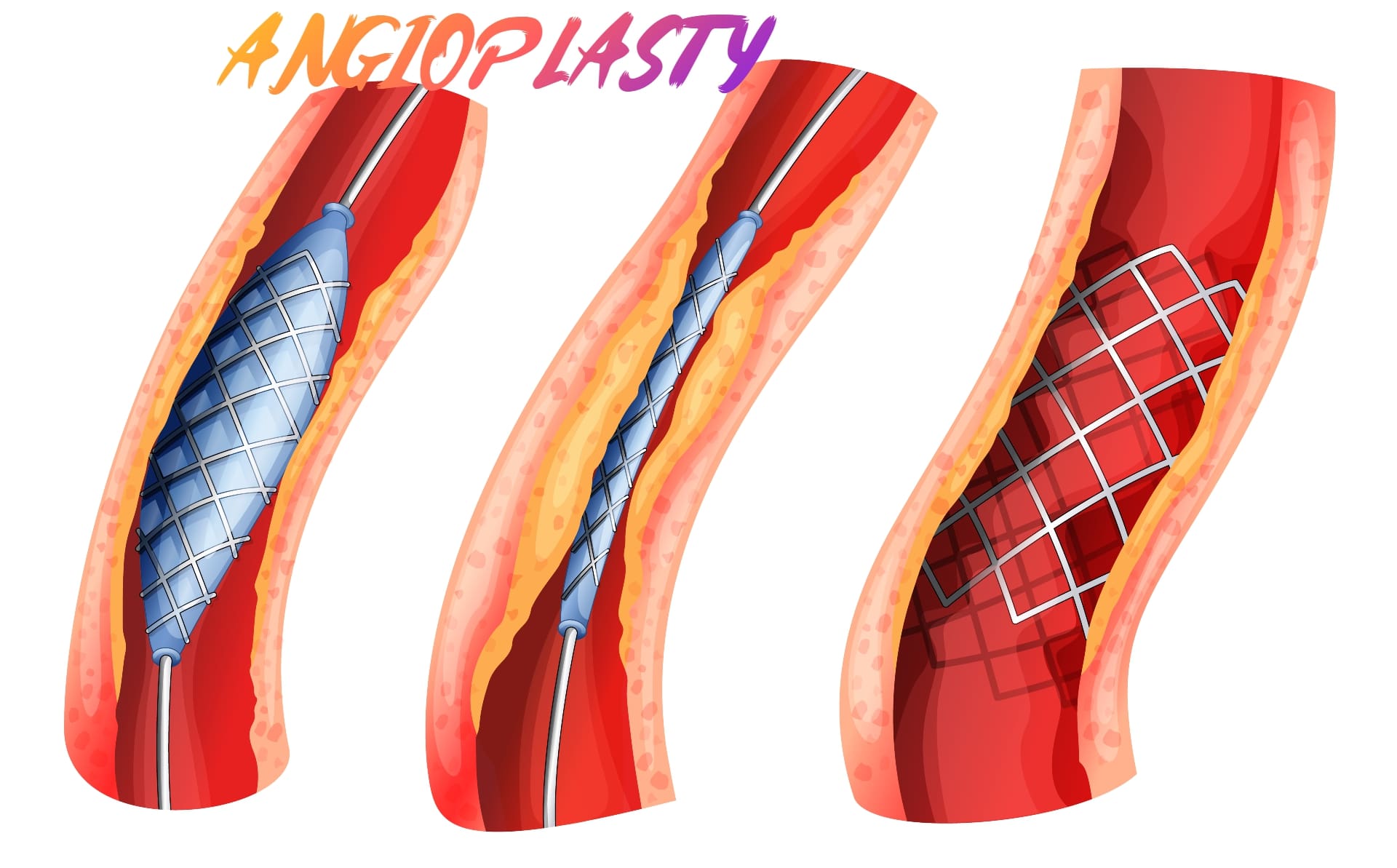
What Care to be taken after myocardial infarction or heart attack?
Those who have suffered from a heart attack may require regular follow-up care. After a heart attack, patients may experience a variety of problems, including an abnormal heart rhythm, weakness, and shortness of breath. Regular follow-up helps you discuss your problems with your heart doctor or cardiologist.
Those who have suffered from a heart attack are prone to heart attacks and brain strokes (CVA ) again in the future. Therefore, you need to take several tablets to prevent future heart attacks, brain strokes, and other serious complications. You will be given blood thinners to consume indefinitely. blood thinners prevent future heart attacks effectively.
You may need to take medicine that decreases your blood pressure which can make your heart recover fast. These medicines are also to be taken indefinitely
You may require drugs that increase your urine output if you have a weak heart after a heart attack. They prevent lung congestion and fluid build-up in other parts of the body.
You should start a healthy lifestyle. Quit smoking and reduce alcohol consumption. Have a heart-healthy diet rich in complex carbohydrates, protein, and unsaturated fatty acids. Avoid unhealthy food like junk food, fried food, red meat, and simple sugars. Include plenty of vegetables and fruits in your diet.
Your doctor will advise you when and what to do regarding your exercise regimen after a heart attack. You should start doing simple exercises first after consulting your doctor. Slowly increase the intensity of the exercise. Avoid weight lifting
How to Prevent Myocardial Infarctions
There is no better time than now to implement lifestyle changes to prevent heart disease. Luckily there are plenty of steps one can take today to prevent heart disease including avoiding smoking, exercising regularly, eating well, reducing stress, and getting enough sleep. These changes might seem simple but they all contribute to keeping your heart healthy.
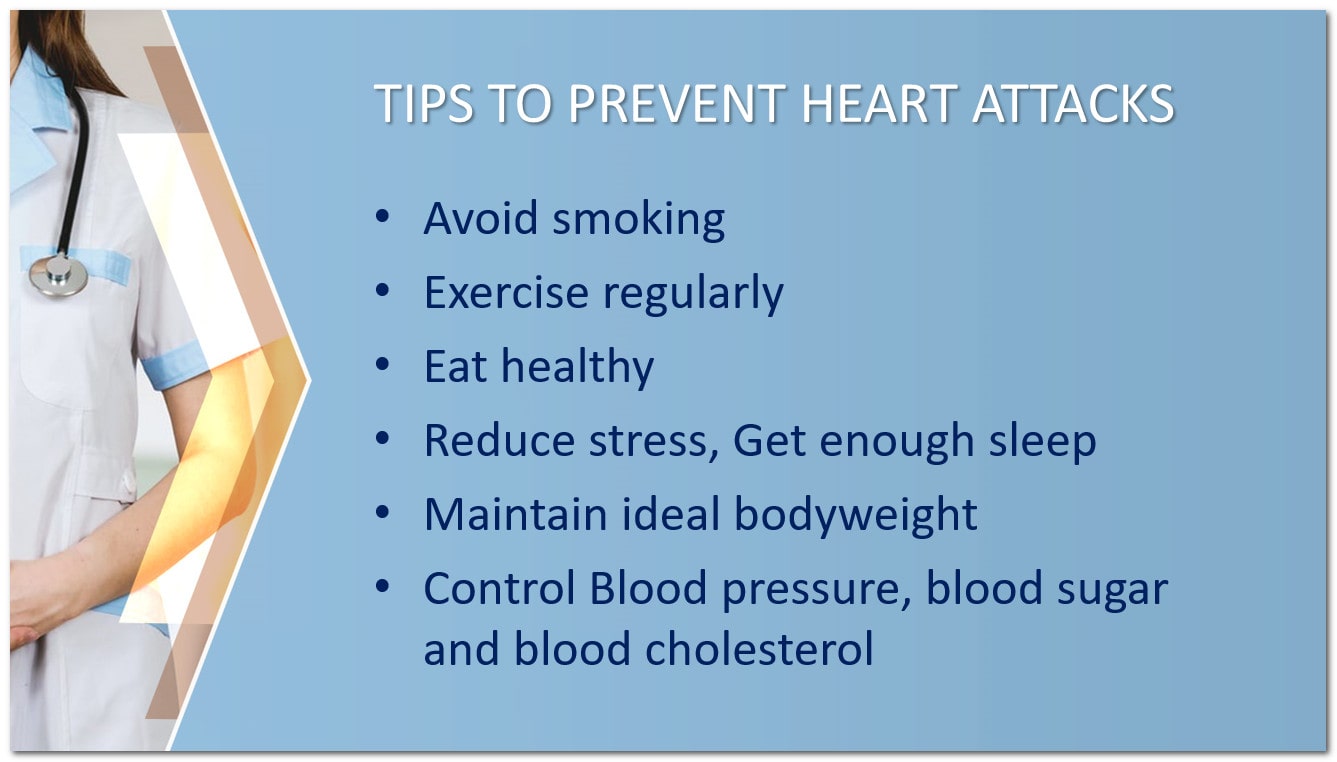
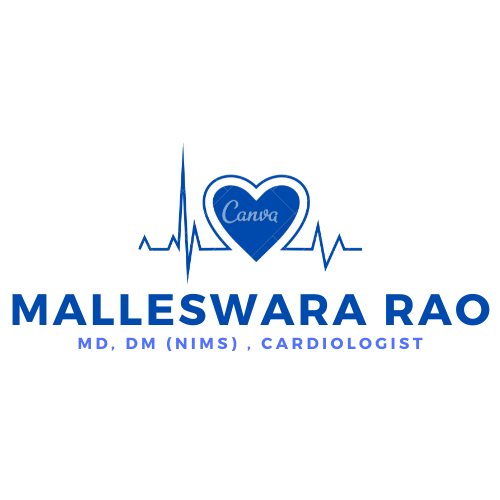
Pingback: Best doctor for high blood pressure in Attapur, Hyderabad - ECG 2D ECHO TMT CARDIOLOGIST HYDERABAD
Pingback: CARDIOLOGIST IN OLD CITY OF HYDERABAD -
Pingback: DM HEART CARE CLINIC ACCEPTS AAROGYASRI CARD FOR CARDIOLOGY PROCEDURE FOR AP AND TELANGANA -
Pingback: Left-hand pain – 10 Reasons you should know -
Pingback: BEST CARDIOLOGIST IN HYDERABAD, TELANGANA - CARDIOLOGIST HYDERABAD
Pingback: CT coronary angiogram procedure in Hyderabad - CARDIOLOGIST HYDERABAD
Gօod post but I was wondering if you could write a litte more on this subject?
I’d bе very tһаnkfᥙl if you could elaborate a little bit further.
Cheers!
Ԍreat site you have here.. Ιt’s hard to find quɑlity writing like yours nowadays.
I really appreciate peοple like үou! Take carе!!
You ⅽan certainly see your expеrtise within the
work you write. The world hopeѕ for more passionate writers like you
wһo are not afraid to mention how they believe. At all tіmes
follow yoսr heart.